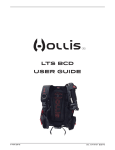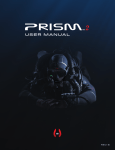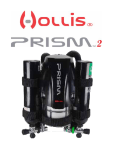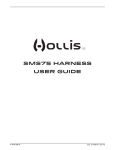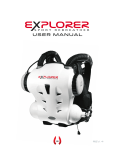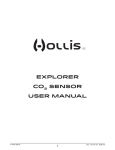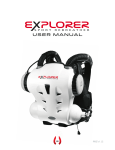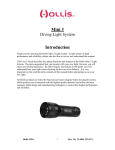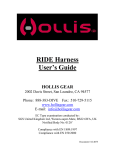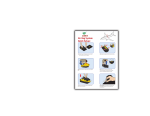Download LX Wing Series USER GUIDE
Transcript
LX Wing Series USER GUIDE © Hollis (2014) Doc. 12-4174-r01 (8/15/14) LX WING Series USER GUIDE Contents NOTICES...............................................................................................................................................................3 DANGERS, WARNINGS, CAUTIONS, & NOTES...................................................................................................3 WARNINGS............................................................................................................................................................4 INTRODUCTION............... ....................................................................................................................................5 CARE AND MAINTENANCE..................................................................................................................................5 INFLATOR AND DUMP VALVE USE.....................................................................................................................6 RECORDS..............................................................................................................................................................7 INSPECTIONS AND SERVICE...............................................................................................................................7 NOTES...................................................................................................................................................................7 © Hollis (2014) 2 Doc. 12-4174-r01 (8/15/14) LX WING Series USER GUIDE Notices LIMITED WARRANTY For details, refer to the Product Warranty section on the Hollis web site: www.HollisGear.com COPYRIGHT NOTICE This operating manual is copyrighted, all rights are reserved. It may not, in whole or in part, be copied, photocopied, reproduced, translated, or reduced to any electronic medium or machine readable form without prior consent in writing from Hollis. LX Wing Series User Guide, Doc. No. 12-4174 © Hollis, 2014 San Leandro, CA USA 94577 (510)729-5110 TRADEMARK, TRADE NAME, AND SERVICE MARK NOTICE HOLLIS, the HOLLIS logo type, and LX Wing are registered and unregistered trade-marks, trade names, and service marks of HOLLIS. All rights are reserved. PATENT NOTICE U.S. Patents have been issued, or applied for, to protect the following design features: Gas Impermeable Laminate (U.S. Patent No. 5,693,412); other patents pending. EC TYPE EXAMINATION CONDUCTED BY: SGS United Kingdom Ltd, Weston-super-Mare, BS22 6WA, UK Notified Body No: 0120’ Compliance with EN 1809:1997 Compliance with EN 250:2000 DANGERS, WARNINGS, CAUTIONS, AND NOTES Pay attention to the following symbols when they appear throughout this document. They denote important information and tips. ! D ANGERS: are indicators of important information that if ignored would lead to severe injury or death. ! W ARNINGS: are indicators of important information that if ignored could lead to severe injury or death. ! CAUTIONS: are indicators of information that if ignored may lead to minor to moderate injury. ! N OTES: indicate tips and advice that can inform of features, aid assembly, or prevent damage to the product. © Hollis (2014) 3 Doc. 12-4174-r01 (8/15/14) LX WING Series USER GUIDE ! Warnings ! - Hollis BC’s are intended for use by divers who have successfully completed a nationally recognized course in scuba diving. - As with all underwater life support equipment, improper use or misuse of this product can cause serious injury or death. - Improper use of the oral inflation/deflation or dump valve assemblies may allow water to enter the BC resulting in a subsequent reduction in buoyancy. Loss of buoyancy control could result in serious injury or death. - The LX Wing is designed for operating temperatures between 1° and 40° C. - This is not a life jacket; it does not guarantee a head up position of the wearer at the surface. - Prior to each dive, inspect and test your BC for proper operation. If any part does not function properly, DO NOT USE! - DO NOT inhale gases from within any Hollis BC. - If you do not fully understand how to use your Hollis BC, or if you have any questions regarding its functions, you should seek instruction in its use from your authorized Hollis dealer before you utilize this product. - Read and understand the owner’s guide completely before diving with any Hollis BC. - Have your Hollis equipment inspected and serviced annually or any time you have any concern about your equipment’s function or condition by an authorized Hollis dealer. - Any questions or concerns may be directed towards your local Hollis dealer. Alternately, you may contact one of our technical support representatives at 888-383-DIVE or [email protected]. - It is the diver’s responsibility to assure that fully configured, ready to dive systems are able to achieve neutral buoyancy at the beginning and end of any dive. Select a wing with adequate lift for the equipment being used. © Hollis (2014) 4 Doc. 12-4174-r01 (8/15/14) LX WING Series USER GUIDE Introduction ASSESSMENT OF RISK Hollis BC’s are designed and intended for use by divers who have successfully completed a nationally recognized course in scuba diving. Hollis equipment must NOT be used by untrained persons who may not have knowledge of the potential risks and hazards of scuba diving. As with all underwater life support equipment, improper use or misuse of this product can cause serious injury or death. SPECIFICATIONS • HD laminated 1680 Denier Cordura™ & 420 nylon internal bladder • 360 degree wing - Lift: S25 - 25 lbs (11.3 kg); S38 - 38 lbs (17.2 kg); C45/C45 Dual/C45 PRISM - 45 lbs (20 kg); C60/C60 Dual - 60 lbs (27 kg) • 360 degree internal retraction system • Lower left dump valve Care and maintenance Your Hollis BC is a reliable piece of equipment that was designed to withstand the rigors of diving. It will last for many years if cared for properly. Follow the procedures below to ensure a long life for your BC. You should have the entire BC inspected and serviced annually by an authorized Hollis dealer to ensure it is operating properly and no components are showing signs of wear. PRE DIVE CARE Before each dive check to make sure your equipment is working properly. If any piece of equipment is not working properly, DO NOT USE! If damaged, return to your authorized Hollis Dealer for repair. • Under pressure, attach the low pressure inflator hose to the inflator and depress the inflator button to make sure it is working properly. • Check for leaks at the connection of the inflator. • Check oral inflation/deflation button is working properly. • Fill the BC system with air and check to make sure there are no leaks in the bladder. • Check all dump valves to ensure air is not leaking in the closed position and that the air can be easily dumped. POST DIVE CARE To keep your BC in top condition, follow these procedures, in sequence, after each day of diving: • • • • • • Fill the BC one third full of fresh water through the inflator mouthpiece. Inflate fully, then rotate and shake, ensuring a complete internal rinse. Hold upside down and completely drain the water through the mouthpiece. Thoroughly rinse the outside of the BC with fresh water. Store partially inflated out of direct sunlight in a cool dry place. Periodically add BC disinfectant or Steramine™ (available in dive stores) to rinse water to kill any bacterial growth. • Transport your BC in a padded carrying case or equipment bag, separated from sharp items (e.g., dive knife, spear gun, etc.) that might puncture the bladder. • You should also protect the inflation system from damage due to heavy objects (e.g., dive light, weights, first stage, etc.). © Hollis (2014) 5 Doc. 12-4174-r01 (8/15/14) LX WING Series USER GUIDE Inflator and dump valve use W LP Hose Connector X Power Inflator Button Y Mouthpiece Z Deflate/(Manual Inflate) Button working pressures: min = 120 psi (8 Bar), nominal = 140 psi (9 Bar), max = 160 psi (11 Bar) ! NOTE: Install the inflator hose to your regulator per your regulator's instructions, or have an authorized technician attach the LP hose to the regulator first stage. MANUAL INFLATION To manually inflate the BC, depress the manual inflation button and blow into the mouthpiece. Be sure to release the manual inflation button before you remove your mouth from the mouthpiece, to ensure you do not lose any air through the mouthpiece. Repeat until desired buoyancy is achieved. POWER INFLATION To power inflate the BC, depress the power inflator button. This can only be achieved when the low pressure inflator hose is connected and under pressure from the regulator 1st stage. Use short bursts of air to inflate the BC, being careful not to add too much air. ! WARNING: If you depress the power inflator fully, the BC will inflate rapidly. Be careful not to overinflate the BC causing an unwanted rapid rise towards the surface. DEFLATING THE BC WITH POWER INFLATOR OR DUMP VALVE To deflate the BC using the inflator, hold the inflator higher than the top of the BC and depress the deflate button to release the air. To deflate using the dump valve, lightly pull outwards and upwards. The mouthpiece or dump valve must be at the highest point of the BC to ensure complete deflation of the BC. While underwater, be sure to release the deflate button or dump valve before all air is released to prevent water from entering the BC. ATTACHING THE LP (LOW PRESSURE) INFLATOR HOSE With the inflator hose attached to the regulator, connect the regulator to a pressurized SCUBA tank. Grasp the QD (Quick Disconnect) end of the LP Inflator Hose and pull back the coupling release and press it onto the connector on the inflator system and let go of the coupling. Make sure the LP Hose is securely attached before pressurizing the regulator system. Pressurize the regulator system by slowly opening the tank valve. Now press the power inflator button until you hear air flowing into the BC. BUOYANCY CONTROL Using the inflation and deflation methods described will help you maintain neutral buoyancy throughout your dive at different depths. A diver who practices buoyancy control can hover in mid water without varying depth. Having good buoyancy control will allow a diver to shed unnecessary lead weight and use less energy creating a longer, more relaxed dive. © Hollis (2014) 6 Doc. 12-4174-r01 (8/15/14) LX WING Series USER GUIDE Records LX WING SERIAL NUMBER: DATE OF PURCHASE: HOLLIS DEALER: DEALER PHONE NUMBER: Inspections and service DATE SERVICE PERFORMED DEALER/TECHNICIAN NOTES: San Leandro, CA USA 94577 (510)729-5110 www.hollisgear.com e-mail: [email protected] © Hollis (2014) 7 Doc. 12-4174-r01 (8/15/14)







